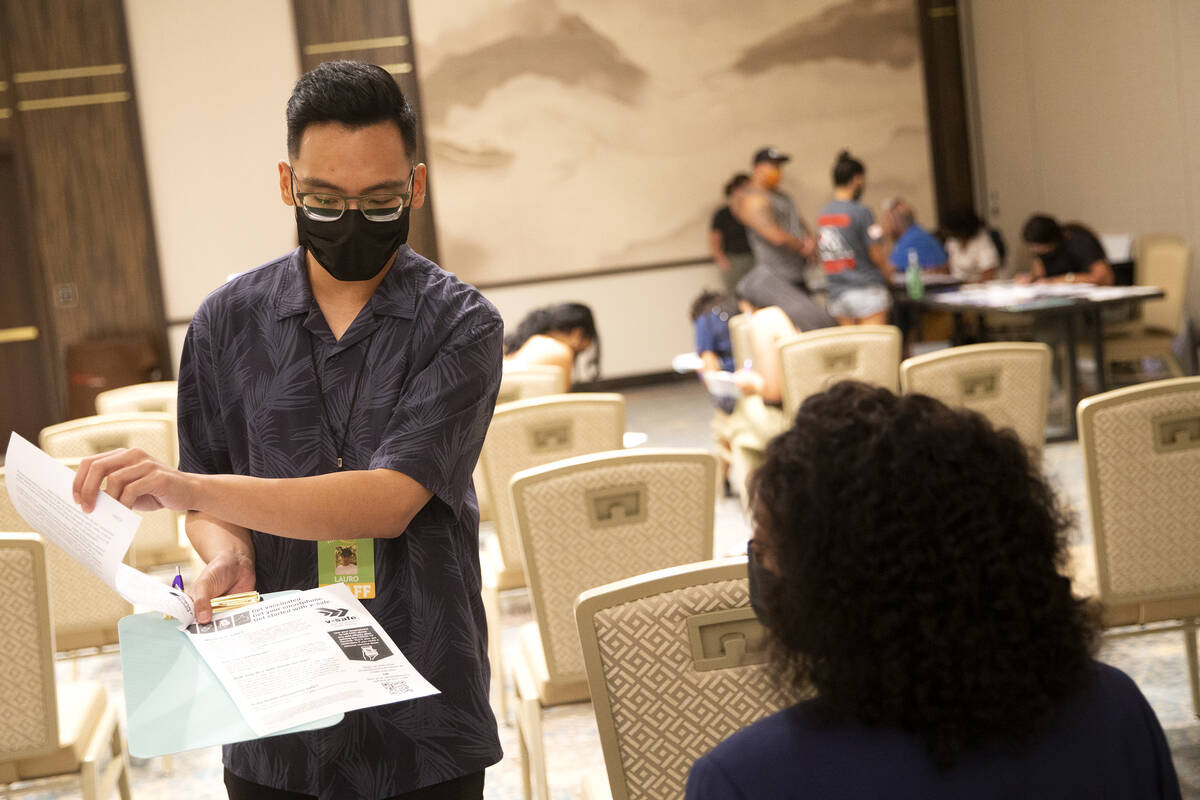Clark County moves from ‘high’ to ‘substantial’ risk of COVID-19 spread
After two and a half months of slowly improving COVID-19 metrics, Clark County has been downgraded from “high” to “substantial” in the Centers for Disease Control and Prevention’s transmission risk categories, bringing the county closer to exiting the state’s face mask mandate for indoor public spaces.
Data on the CDC’s COVID tracker web page early Monday showed the seven-day average in the county of 92.69 cases of the disease per 100,000 residents. That was down sharply from the average of 109.59 cases per 100,000 the agency reported on Friday, moving the county into the “substantial” risk of transmission category for the first time since the mask mandate was announced by Gov. Steve Sisolak on July 27.
The county already is considered to be at “moderate” risk for its COVID-19 test positivity rate, which has remained below 8 percent since Oct. 4.
To exit the face mask mandate, both metrics must be in the moderate category, meaning the positivity rate must remain below 8 percent until the county registers back-to-back weeks with a seven-day average of 50 new COVID-19 cases per 100,000 residents or lower.
That good news from the feds was tempered, however, by updated data posted Monday by the Southern Nevada Health District, which showed a surge of new COVID-19 cases in the county over the preceding three days.
The 1,074 new COVID-19 cases and three deaths pushed totals for the county to 332,660 cases and 5,977 deaths.
Data guide: COVID-19’s impact on Nevada
Spread over three days, the daily average of new cases was slightly above the 14-day moving average of 321 per day. The average itself, however, jumped sharply from the 293 per day reported on Thursday, the most recent available data from the state due to the official Nevada Day holiday celebration on Friday.
Fatalities were below the county’s 14-day moving average of four per day, while the average declined by one from Thursday’s report.
State and county health agencies often redistribute daily data after it is reported to better reflect the date of death or onset of symptoms, which is why the moving-average trend lines frequently differ from daily reports and are considered better indicators of the direction of the outbreak. Updates following weekends also can be affected by reporting lags.
The county test positivity rate, which tracks the percentage of people tested for COVID-19 who are found to be infected, declined 0.2 percentage points to 5.8 percent, state data showed.
There were 465 confirmed and suspected COVID-19 patients occupying county hospital beds as of Monday’s update, up from 452 on Thursday.
The state Department of Health and Human Services, meanwhile, reported 2,682 new COVID-19 cases and 56 deaths across Nevada over the preceding four days.
That raised totals for the state to 440,251 confirmed cases and 7,656 deaths.
New cases, which averaged 670.5 per day over the period, were well above the 14-day moving average of 505. The average, itself was up sharply from the 473 cases per day reported as of Thursday.
Remembering Nevadans lost to COVID-19
The average of 14 deaths per day over the four-day period were more than double the 14-day moving average of six per day, which was down from the nine per day reported on Thursday.
There were 666 confirmed and suspected COVID-19 hospitalizations as of Monday’s update, 31 more than Thursday’s total.
The state’s test positivity rate, however, shaved 0.2 percentage points off Thursday’s figure to drop to 6.6 percent.
Monday’s update showed that 56.35 percent of the state’s eligible residents 12 and up have been fully vaccinated, compared to 55.62 percent in Clark County.
Contact Mike Brunker at mbrunker@reviewjournal.com or 702-383-4656. Follow @mike_brunker on Twitter.
Nevada vaccinations
—12+ population: 2.64 million.
— Doses administered: 3.33 million.
— Vaccinations initiated: 1.78 million.
— Vaccinations completed: 1.54 million.
— Eligible fully vaccinated: 56.35 percent.
Sources: Department of Health and Human Services; U.S. Census Bureau











































